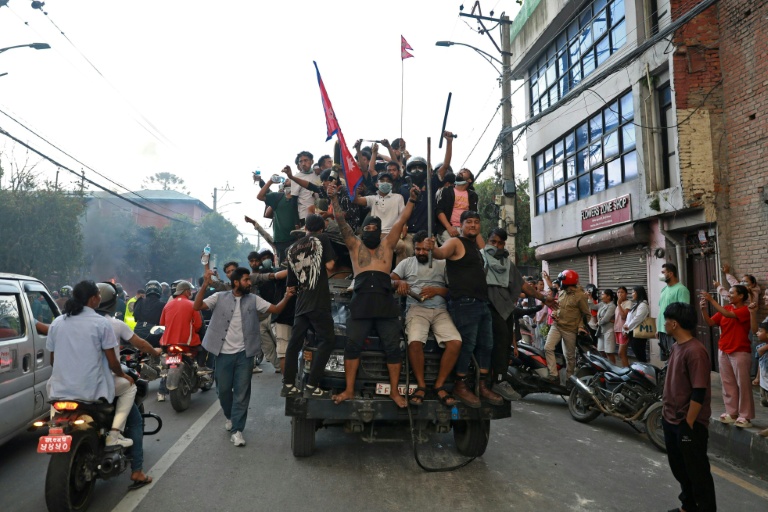Science
Nepal’s Protests Spark Misleading Claims of Religious Unrest

Protests in Nepal have escalated dramatically, leading to the ousting of Prime Minister KP Sharma Oli and resulting in significant damage to government property. The unrest was primarily driven by young demonstrators opposing a government ban on social media and rampant corruption. However, these protests have been mischaracterized in neighboring India as a religious uprising, prompting a wave of misinformation across social media platforms.
The protests, which began in Kathmandu on March 15, 2024, have been fueled by a passionate youth movement identifying themselves as the “Gen Z” movement. Demonstrators expressed their outrage not only against governmental restrictions but also against perceived injustices, leading to widespread violence and the burning of government buildings. Subsequent to the protests, Oli resigned from his position after his residence was set ablaze.
Misrepresentation of Events
In India, right-wing broadcasters and politicians have distorted the narrative of events taking place in Nepal. Claims that the protests are a demand for a “Hindu state” or an attack on Hinduism have proliferated. Notably, the Pashupatinath Temple, a significant Hindu site, has been at the center of these allegations. An anchor from the right-leaning Zee News reported that some rioters attempted to vandalize the temple, stating, “It was only after this incident that the army was deployed.”
However, investigations by fact-checkers from AFP have debunked these claims, tracing the footage of the alleged vandalism to a separate religious ritual called Naxal Bhagwati Jatra, filmed weeks before the protests began. KN Swami, a respected monk at the temple, confirmed via social media that the temple remained peaceful and unscathed during the protests.
Unfounded Allegations and Social Media Impact
Despite the lack of evidence, many social media posts have claimed that the protests were “instigated and funded” by “anti-Hindu forces and Islamists” targeting religious sites. Protests in Nepal, a secular republic since 2008, have often seen factions calling for the restoration of a Hindu state. Old footage from previous demonstrations has resurfaced, misleadingly presented as evidence of the current protests being primarily religious in nature.
Additionally, images circulated with claims that protesters want India’s Hindu monk Yogi Adityanath as Nepal’s new prime minister have gained traction, further distorting the narrative. These misleading posts have amassed thousands of views on platforms like X, Instagram, Threads, and Facebook, where hashtags advocating for a “Hindu Nation”—a slogan popularized by the BJP—have trended extensively.
Prashant Das, a senior research fellow at South Asian University, noted that the rush to break news in India has contributed to the spread of misinformation. “What is rife now are speculations and rumors, which are natural responses of people in such situations,” Das remarked.
The ongoing situation in Nepal reflects not only the local grievances against government authority but also highlights how regional dynamics can influence perceptions and narratives across borders. As the protests continue, the need for accurate reporting and a clear understanding of the events is more critical than ever.
-

 Education3 months ago
Education3 months agoBrandon University’s Failed $5 Million Project Sparks Oversight Review
-

 Science4 months ago
Science4 months agoMicrosoft Confirms U.S. Law Overrules Canadian Data Sovereignty
-

 Lifestyle3 months ago
Lifestyle3 months agoWinnipeg Celebrates Culinary Creativity During Le Burger Week 2025
-

 Health4 months ago
Health4 months agoMontreal’s Groupe Marcelle Leads Canadian Cosmetic Industry Growth
-

 Technology3 months ago
Technology3 months agoDragon Ball: Sparking! Zero Launching on Switch and Switch 2 This November
-

 Science4 months ago
Science4 months agoTech Innovator Amandipp Singh Transforms Hiring for Disabled
-

 Education3 months ago
Education3 months agoRed River College Launches New Programs to Address Industry Needs
-

 Technology4 months ago
Technology4 months agoGoogle Pixel 10 Pro Fold Specs Unveiled Ahead of Launch
-

 Business3 months ago
Business3 months agoRocket Lab Reports Strong Q2 2025 Revenue Growth and Future Plans
-

 Technology2 months ago
Technology2 months agoDiscord Faces Serious Security Breach Affecting Millions
-

 Education3 months ago
Education3 months agoAlberta Teachers’ Strike: Potential Impacts on Students and Families
-

 Science3 months ago
Science3 months agoChina’s Wukong Spacesuit Sets New Standard for AI in Space
-

 Education3 months ago
Education3 months agoNew SĆIȺNEW̱ SṮEȽIṮḴEȽ Elementary Opens in Langford for 2025/2026 Year
-

 Technology4 months ago
Technology4 months agoWorld of Warcraft Players Buzz Over 19-Quest Bee Challenge
-

 Business4 months ago
Business4 months agoNew Estimates Reveal ChatGPT-5 Energy Use Could Soar
-

 Business3 months ago
Business3 months agoDawson City Residents Rally Around Buy Canadian Movement
-

 Technology2 months ago
Technology2 months agoHuawei MatePad 12X Redefines Tablet Experience for Professionals
-

 Business3 months ago
Business3 months agoBNA Brewing to Open New Bowling Alley in Downtown Penticton
-

 Technology4 months ago
Technology4 months agoFuture Entertainment Launches DDoD with Gameplay Trailer Showcase
-

 Technology4 months ago
Technology4 months agoGlobal Launch of Ragnarok M: Classic Set for September 3, 2025
-

 Technology4 months ago
Technology4 months agoInnovative 140W GaN Travel Adapter Combines Power and Convenience
-

 Science4 months ago
Science4 months agoXi Labs Innovates with New AI Operating System Set for 2025 Launch
-

 Top Stories2 months ago
Top Stories2 months agoBlue Jays Shift José Berríos to Bullpen Ahead of Playoffs
-

 Technology4 months ago
Technology4 months agoNew IDR01 Smart Ring Offers Advanced Sports Tracking for $169










